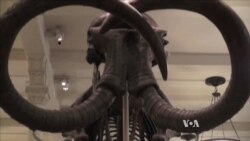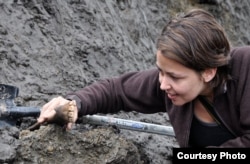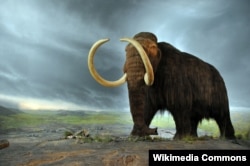An international team of scientists recently sequenced the complete genome of the woolly mammoth. Led by the Swedish Museum of Natural History in Stockholm, the work opens the door to recreate the huge herbivore, which last roamed the Earth 4,000 years ago.
Ancient bones in cold, remote places
Beth Shapiro searches for old bones in remote places. On a field trip to the Klondike gold fields in Canada’s Yukon Territory, the expert in ancient DNA from the University of California, Santa Cruz, worked alongside mining operators as they blasted water from frozen layers of mud. What surfaced from the 700,000 year old permafrost were mammoth, bison and horse bones.
That adventure makes its way into Shapiro’s new book, How to Clone a Mammoth, in which she imagines bringing the elephant's ancient cousin back to life. But she says 'de-extinction' is a complicated process, riddled with technical, ethical and ecological challenges.
In the mid-1990s, Scottish researchers cloned a sheep. Dolly was the first mammal to be cloned from an adult cell. Her birth sparked fears and speculation about human cloning.
But Shapiro said cloning is not even an option for the mammoth.
“Once an organism dies, there is no living material that remains,” she explained. “The DNA starts to be broken down immediately by things like UV radiation and enzymes from soil bacteria or even inside the gut of the organism itself and the DNA starts to degrade right away. There are no living cells, so we can’t clone an extinct species.”
Genomics is pathway to de-extinction
Genomics offers another pathway to resurrecting a species. The team that mapped the mammoth genome compared that genetic sequence with the Asian elephant, the mammoth’s closest living relative.
Shapiro said identifying the differences between the two species sets the stage for genomic editing.
“In essence this genome editing technology is going to swap out bits of an elephant genome for the mammoth version of genes that we know are critical to making a mammoth look and act like a mammoth, turning an Asian elephant a little bit at a time into a mammoth.”
But Shapiro admitted this wouldn’t really recreate the mammoth, just something mammoth-like. And for what, asked Ross MacPhee, curator of mammals at the American Museum of Natural History in New York, where mammoths and other bygone species are on display.
“If the animals themselves have no further ecological role because they’ve disappeared for hundreds and even thousands of years," he wondered, "what does it mean to bring them back and park them in an environment to which they really have no relationship anymore?”
Why bring back a species
Shapiro argued, “the present focus on bringing back particular species – whether that means mammoths, dodos, passenger pigeons, or anything else – is misguided. In my mind, de-extinction has a place in our scientific future, but not as an antidote to extinctions that have already occurred.”
“Extinct species are gone forever,” she writes in her book, pointing out there is still a reason to pursue de-extinction.
“If we can create an animal that by bringing this animal back or bringing the traits back of an extinct species, we can somehow save living species or reestablish or reinvigorate existing ecosystems," she said.
"If we can use this technology not to bring back the past, but to protect living species, and populations and ecosystems in danger of extinction today from going extinct, then that is a powerful and compelling use of this technology.”
Broader public discussion needed
MacPhee is not so sure. “I do not think that de-extinction is going to go very far to solving any important environmental, evolutionary or ecological problems.”
He added that the concept deserves a broader public discussion. “Human manipulation of the biosphere is a serious and on-going problem. I think the only way forward is to have the conversation and get people aware of what the issues are and one hopes over time to have both political and economic and solutions.”
Shapiro said she welcomes the discussion, especially before a de-extinction takes place, which she says given the technical, ethical and ecological challenges, will not occur for a very long time.











